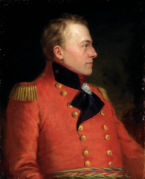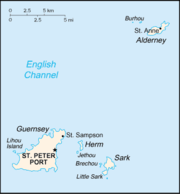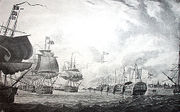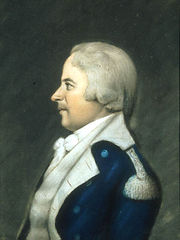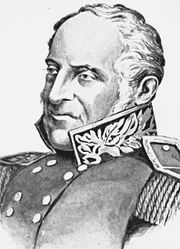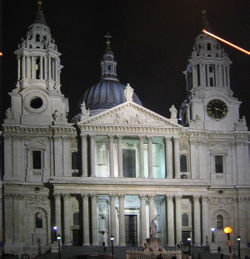Isaac Brock
2007 Schools Wikipedia Selection. Related subjects: Military People
| Isaac Brock | |
|---|---|
|
Major General Sir Isaac Brock, portrait by John Wycliffe Lowes Forster
|
|
| Born | 6 October 1769, St Peter Port, Guernsey. |
| Died | 13 October 1812, Queenston Heights, Canada. |
Major-General Sir Isaac Brock KB ( 6 October 1769 – October 13, 1812) was a British Major-General and administrator. Brock is best remembered as a brilliant leader and strategist for his actions while stationed in the Canadian colonies. His efforts earned him a knighthood, accolades, and the moniker The Hero of Upper Canada.
Brock was assigned to Canada in 1802, and became responsible for defending the territory from the United States during the War of 1812. While many in Canada and in Britain believed war could be averted, he began readying the army and militia for what was to come. When war broke out, the populace was prepared — and quick victories at Fort Mackinac and Detroit crippled American invasion efforts.
During Sir Isaac's tenure he faced desertions and near mutinies, was injured in battle and nearly died from fever. His heroics earned him membership in the Order of the Bath, and he had the privilege of serving alongside Lord Nelson and Tecumseh. His death in the Battle of Queenston Heights was a crushing blow to British leadership.
Early life
Brock was born in Saint Peter Port on the Channel Island of Guernsey, as the eighth son of a middle class family. He earned a reputation during his early education as a good swimmer and boxer. He kept a reputation as a physically commanding man throughout his life, and is said to have stood between 6 ft 2 in and 6 ft 4 in (1.88 and 1.93 m) in height. He was also noted as a serious student, who took education very seriously, even at a young age. Following in the footsteps of his father and three of his older brothers, Brock decided to join the British military.
Military service
Although he is best known for his capture of Detroit and other actions in the War of 1812, Brock had a successful pre-war career, and a quick rise through the ranks which many commented on at the time. Some credited luck, and others skill, in his rapid promotions, and it is fair to say that Brock had substantial portions of both on his way to prominence.
Early career
Brock started as an ensign in the 8th Regiment of Foot in 1785 at the age of fifteen, where he was likely given responsibility for the regimental colours. Brock reached the rank of captain, and transferred to the 49th Regiment of Foot (also known as the Hertfordshire Regiment of Foot) on June 15, 1791. His nephew and biographer ( Ferdinand Brock Tupper) asserts that shortly after joining the regiment, a professional dueller forced a match on him. As the one being challenged, Brock had his choice of terms, and so he insisted that they fight with pistols. His friends were shocked, as Brock was considered only a moderately good shot, while this man was an expert. Brock, however, refused to change his mind. When the duellist arrived at the field, he asked Brock to decide how many paces they would take. Brock subsequently insisted that the duel would take place, not at the usual range, but at handkerchief distance. The duellist declined and subsequently was forced to leave the regiment. This contributed to Brock's popularity and reputation among his fellow officers, as this duellist had a formidable reputation, and thus bullied other officers without fear of reprisal. During his time with this regiment, he served in the Caribbean. At some point during his service there, Brock fell ill with fever and nearly died; only recovering once he had returned to England.
First command
In 1797, Brock purchased the rank of Lieutenant Colonel, and became commander of the regiment. In 1799, the 49th was assigned to an expedition against the Batavian Republic (now known as the Netherlands), to be led by Sir Ralph Abercromby. During the troop landings, Brock saw his first combat, on September 10, 1799, under the command of then-Major General John Moore. Given that the 49th was in poor shape when Brock took command, they saw little of the actual combat. Likely Moore was sparing them, and using more experienced troops to establish the beachhead. Finally, on October 2, the 49th was actively involved in heavy combat, at Egmont-op-Zee, where they acquitted themselves well, only sustaining thirty-three fatalities. This was remarkable given the circumstances of the fight. The 49th had been ordered to proceed up the beaches of Egmont-op-Zee, a steep climb through sand dunes and poor terrain. The situation was exacerbated by harassment from French sharpshooters, who had excellent cover. After about six hours of heavy fighting, the attack was stopped about a mile (1.6 km) short of their objective. After an hour of close combat, including fist and sabre fighting, the French began to withdraw. Brock himself was injured in the fighting, when he was hit by a spent musket ball in the throat. A neck cloth prevented a possibly fatal injury. In his own words, "I got knocked down shortly after the enemy began to retreat, but never quitted [sic] the field, and returned to my duty in less than half an hour."
In 1801, while aboard the 74 gun HMS Ganges (commanded by Captain Thomas Fremantle, a personal friend of Brock's), Brock was present at the Battle of Copenhagen, where it was intended that his troops would lead an assault on the forts at Copenhagen. Although the outcome of the battle made such an assault unnecessary, Brock observed first hand the tactical brilliance of Lord Nelson. After the battle, along with Fremantle, he was among those to personally congratulate Nelson. In 1802, Brock and the 49th Foot were ordered to Canada.
Transfer to Canada
Brock arrived in Canada, along with the rest of the 49th foot, and was initially assigned to Quebec City. As foot soldier Jake Batchelor put it, "Such a sweet sight had never been seen by the men in all our travels." Almost immediately, in 1803 he was faced with one of the primary problems in Canada, desertion. Seven soldiers stole a boat and fled across the border into the United States. Brock sent a party across the border in pursuit, and the men were captured.
Mutiny
A short time later, Brock was sent a report by an officer at Fort George that some of the garrison were planning to imprison the officers and flee to the U.S. Immediately, he boarded the schooner that had brought the message and went on it to Fort George, which was under the command of then-Lieutenant Colonel Roger Hale Sheaffe. A hastily assembled honour guard formed to greet Brock's unexpected arrival. Accompanied by an orderly and another soldier who would form his reputation in Canada, James Fitzgibbon, Brock had the sergeant of the guard disarmed and confined. Then he entered the fort.
As it was the dinner hour, all the soldiers were in barracks. Brock sent his orderly to bring him a soldier suspected of being one of the mutiny's ringleaders. As soon as he entered the room Fitzgibbon pinned the man and threatened to kill him if he cried out. One at a time, other suspected mutineers were captured in the same way. Finally, Brock ordered the drummers to assemble the men. They filtered out of the barracks and formed a line in front of Brock. Brock ordered that all men involved in the mutiny step forward, and a number did so, and were arrested. Brock then addressed the regiment, and asked for the obedience of those who had not known about the mutiny. The men pledged this obedience, and returned to the barracks.
Brock sent the twelve mutineers and the seven deserters to Quebec for court martial. There it was discovered that the mutineers had planned to jail all the officers, save Sheaffe, who was to be killed, and then cross the Niagara River into the U.S. at Queenston. Seven soldiers were subsequently executed by firing squad. Ferdinand Tupper, then aged ten, was present at the trial and executions, and wrote about them to Brock. He described how the mutineers had testified that they were forced to such measures by the severity of Sheaffe, and how, had they continued under Brock's command, they would never have taken such action. Brock was evidently much moved by the letter. As a result of his continued competence, Brock was promoted to colonel on October 30, 1805.
Pre-war preparations
By 1806 the U.S. was becoming increasingly hostile to the British Empire, and relations between the two nations continued to deteriorate until war finally broke out in 1812. This hostility came from two sources: grievances at violations of American sovereignty and restriction of trade by Britain, and a desire to annex the poorly-defended British North American colonies to gain territory. American grievances included the impressment of American sailors by the Royal Navy, the blockade of French ports and a belief that the British were inciting American Indians to attack U.S. settlements on the western frontier. War hawks in the U.S. called for an invasion of Canada to punish the British Empire and to lessen the threat to American interests represented by the Native Americans. At the same time, the American colonies were becoming crowded, and there was a growing attitude—later described by the phrase Manifest Destiny—that the United States was destined to control all of the North American continent. American hawks assumed that Canadian colonists would rise up and support the invading U.S. armies as liberators, and that, as Thomas Jefferson assured the American public, conquering Canada would be easy. In response to this emerging threat, Brock moved quickly to bolster Canadian defences. He strengthened the fortifications of Quebec by building walls and an elevated battery. Despite having little formal education, Brock succeeded in creating a formidable defensive position largely due to his reading, which included several volumes on the science of running and setting up artillery. He also rearranged the marine department (responsible for lakes and rivers), which led to the development of a naval force capable of holding the Great Lakes. This was to be pivotal during the war.
In 1807, Brock was made a brigadier-general by Governor General Sir James Henry Craig. He was to take command of all forces in Upper Canada in 1810. During this time, Brock continued to ask for a posting in Europe. In 1811 he was promoted to Major General, and in October of that year, Lieutenant Governor Francis Gore left for England. This made Brock the provisional Lieutenant Governor, and as such, administrator of Upper Canada, putting him fully in charge of both the military and civil authority. Thus, when permission to leave for Europe finally came in early 1812, Brock declined the offer, seeing it as his duty to defend Canada in war against the United States.
As Upper Canada's administrator, Brock made a series of changes designed to help Canada in the event of a war. He amended the militia act, allowing the use of all available volunteers, and he ordered enhanced training of these raw recruits, despite opposition from the provincial legislature. Furthermore, he continued strengthening and reinforcing defences. Also, Brock began seeking out American Indian leaders, such as the Shawnee chief Tecumseh, to see if they would ally with him against the Americans in the event of war. Although the conventional wisdom of the day was that Canada would fall quickly in the event of an invasion, Brock pursued these strategies to give the colony a fighting chance.
War of 1812
Early war and the capture of Detroit
The U.S. declared war on Britain during June 12, 1812. Brock's preparations meant that Canada was not unprepared for the war; however, Brock felt that those preparations would not be enough to keep the colony secure. Thus he immediately moved to capture the strategically important Fort Mackinac. This attack was a complete success, but Brock felt he needed to go further. He was hampered in these efforts by the thrusts of Governor General George Prevost (Prevost replaced Craig in late 1811), who favoured a cautious approach to the war. Prevost felt that a strict emphasis should be placed on defence, and was against any attack into American territory.
On July 12, U.S. William Hull invaded Canada at Sandwich (later known as Windsor). The invasion was quickly halted, and Hull withdrew, but this gave Brock the excuse he needed to abandon Prevost's orders. Securing Tecumseh's aid, Brock advanced on Detroit. At this point, even with his American Indian allies, Brock was outnumbered approximately two to one. However, Brock had gauged Hull as a timid man, and particularly as being afraid of Tecumseh's natives. Brock thus decided to use a series of tricks to intimidate Hull. First, he allowed a message (ostensibly to Prevost) declining reinforcements to fall into Hull's hands. The reason given was that Brock had more than enough native allies to take the fort, and thus did not need additional British troops. Then, he dressed his militia divisions in military garb, making it appear as if his force consisted entirly of British Regulars, rather than farmers and blacksmiths. Brock then laid siege to Fort Detroit, and through a carefully crafted series of marches, made it appear he had far more natives with him then he actually did. Additionally, he ordered Tecumseh's forces to make as much noise as possible, thus giving the impression of a much larger force and intimidating Hull with the show of a raucous, barely controlled group of natives. Finally, he sent Hull a letter demanding his surrender, in which he stated, in part, "Sir: it is far from my inclination to join a war of extermination, but you must be aware that the numerous body of Indians who have attached themselves to my troops will be beyond my control the moment the contest commences." Brock then hammered the fort with cannon fire. On August 16, two hours after receiving Brock's letter, Hull surrendered unconditionally.
From Hull's perspective, there was one, paramount reason for his surrender. Detroit was filled with civilians, including Hull's own daughter and grandson, and Hull greatly feared what would happen should he lose the battle. At his court-martial, he stated, "I have done what my conscience directed—I have saved Detroit and the Territory from the horrors of an Indian massacre." This was a huge victory for Brock for a number of reasons. First, it struck a massive blow to American morale, and eliminated the main American force in the area as a threat. Secondly, it gave a badly needed corresponding morale boost to the Canadian population, many of whom had not believed Canada stood a chance against the superior military might of the U.S. (some had even defected to the U.S., and many were recent immigrants from that country). Third, it allowed Brock to take the American supplies at Detroit and use them for his own forces, particularly the ill-equipped militia. Finally, it secured the support of Tecumseh and the other American Indian chiefs, who took it as both a sign of competency and a willingness to take action.
In enlisting the help of Tecumseh, Brock made a number of commitments to the Shawnee. He promised to negotiate no peace treaty without addressing the Shawnee's vision of an independent homeland. Although this was undoubtedly because Brock needed the help of Tecumseh, there is no evidence Brock negotiated in bad faith. Also, Tecumseh evidently trusted and respected Brock, reportedly saying, "This is a man" after meeting him for the first time.
The capture of Detroit also led to British domination over most of Michigan Territory. Brock had planned to continue his campaign into the U.S., but he was thwarted by the negotiation of an armistice by Prevost with American Major General Henry Dearborn. This stalled Brock's momentum, and gave the Americans time to regroup and prepare for an invasion of Canada. Unable to predict the point of invasion, Brock frantically worked to prepare defences throughout Upper Canada.
Death at Queenston Heights
Meanwhile, the American general Stephen Van Rensselaer III, a Federalist political appointee with little military experience, who was in command of a sizeable army near Lewiston, came under presidential pressure to invade. Although Van Rensselaer had severe doubts about the quality of his troops, he had no choice but to attack. Making matters worse, Van Rensselaer was an inexperienced militia general, and thus not trusted by the majority of regular army troops. In the early morning of October 13, 1812, he attempted to cross the Niagara River, leading to the Battle of Queenston Heights. Despite heavy fire from British artillery, the first wave of Americans (under Captain John E. Wool) managed to land, and then follow a fishermen's path up to the heights. From this point, they attacked and beat the British artillery.
From nearby Fort George, Brock hurried to take command of the small British force stationed at the heights. Fearing that the Americans, with the artillery out of the way, would move the rest of their troops across the river, he ordered an immediate attack on their position. True to his personal philosophy of never ordering men where he would not lead them, he personally led the charge. The charge nearly succeeded, but was repelled. Brock himself was wounded in the hand, but then immediately led a second charge. An obvious target in his general's uniform, Brock was shot and killed by American sharpshooters. Brock's last words have been reported as surgite ( Latin for "rise" or perhaps "press on"), or "Push on, brave York Volunteers" (in reference to a group of the militia Brock favoured) and even "My fall must not be noticed or impede my brave companions from advancing to victory." It has also been reported that Brock died immediately, however, so these accounts are by no means certain.
Following his death, Sheaffe arrived at the battle scene and took command of the British forces. In sharp contrast to his predecessor's direct attack, Sheaffe took a more cautionary approach. This ultimately proved successful, leading to a total victory over the Americans at the cost of only 50 of his own men. During the battle, it is reported that the 49th used "Revenge the General" as a battle cry.
Burial
After the battle, Sheaffe and his staff decided to entrust the funeral arrangements to Captain John Glegg, who had served with Brock for many years.
On October 16, a funeral procession for Brock and Colonel Macdonell went from Government House to Fort George, with soldiers from the British Army, the colonial militia, and the American Indian tribes on either side of the route. The caskets were then lowered into a freshly dug grave in the northeast corner of Fort George. The British then fired a twenty-one gun salute in three salvos, in a gesture of respect. Later that day, the American garrison at Fort Niagara respectfully fired a similar salute. Several thousand people attended the funeral, a remarkable number given the population of Upper Canada at that time.
All told, Brock and Macdonell's remains were moved a total of three times, until finally coming to a permanent rest inside Brock's Monument, on October 13, 1853. Between twelve and fifteen thousand people were on hand for the final burial.
Attitudes
Although many Canadians have come to view Brock as one of their own, Brock never really felt at home in Canada. Although he was complimentary toward Quebec City, on the whole Brock viewed the country as a backwater, and earnestly wished to return to Europe to fight against Napoleon . Furthermore, Brock mistrusted the Canadian colonists, many of whom he suspected of being American sympathizers, and was reluctant to arm them to help defend the colonies; he was far happier fighting alongside British regulars and Tecumseh's native fighters.
His attitude towards Tecumseh and his other American Indian allies is noteworthy. Although Brock's correspondence indicates a certain amount of paternal condescension for the natives, he seems to have regarded Tecumseh himself very highly (calling him the "Wellington of the Indians", and saying "a more sagacious or a more gallant warrior does not I believe exist"), and also to have a certain respect for native peoples. Brock's personal integrity has been well documented, and suggests that if he had lived he would have kept his word to provide the Shawnee with their own homeland.
Despite his lack of an extensive formal education, Brock appreciated the importance of it. It is reported that he often spent his leisure time sequestered in his room, reading books in an attempt to improve his education. His tastes varied, and he read many works on military tactics and science, but he also read on philosophy and other, less immediately practical, topics . At the time of his death he was in possession of a modest library of books, including works by Shakespeare, Voltaire, and Samuel Johnson.
Legacy
On British leadership
British military leadership, which had been decisive up to Brock's death, suffered a crushing blow with his loss. His direct successor, Major-General Sheaffe, although successful in his approach at Queenston Heights, was never able to live up to Brock's reputation. He was criticised by many, including John Strachan, for his retreat at the Battle of York, and was shortly after recalled to England, where he went on to have a successful, if not brilliant, military career.
Brock's successor at Detroit, however, fared much worse. Colonel Henry Procter faced an attack from a resurrected American Army of the Northwest under future President William Henry Harrison. Harrison set out to retake Detroit, but a detachment of his army was defeated at Frenchtown on January 22, 1813. Procter, displaying poor judgement, left the prisoners in the custody of his native allies, who proceeded to execute sixty of them. Subsequent American victories allowed Harrison to attempt another invasion of Canada, which led to the Battle of the Thames on October 5, 1813. After a successful American charge, Procter's forces turned and fled, leaving Tecumseh and his American Indian troops to fight alone. They fought on, eventually being defeated. Perhaps of more importance to the British, at this battle Tecumseh died, and their alliance with the American Indians effectively ended.
As for Governor General Prevost, who often clashed with Brock, he remained in command of all British forces until after the Battle of Plattsburgh, in 1814. The battle was intended to be a joint naval/infantry attack, but Prevost did not commit his forces until after the naval battle had nearly ended. When he finally did attack, his forces proved unable to cross the Saranac River bridge, which was held by a small group of American regulars under the command of the recently promoted Wool. Despite a heavy advantage in manpower, Prevost finally retreated upon hearing of the failure of the naval attack. For his failure at Plattsburgh, Prevost was recalled to England to face an inquiry. Prevost's health failed him, and he died in early 1815.
In Canada
Canadians regard Brock as one of their greatest military heroes, since he helped save the Canadian colonies when all seemed hopeless. He was even voted #28 on The Greatest Canadian, despite not actually being a Canadian. A web-based survey by the Angus Reid polling group placed him as the greatest of Canadian military heroes. A small cairn at the foot of the Niagara Escarpment marks the spot where Brock fell, while an impressive monument, built by public subscription, overlooks the Heights as a lasting tribute. The monument was bombed and heavily damaged in 1840 by Irish-Canadian terrorist Benjamin Lett, but it was later repaired, although the bodies inside had to be temporarily moved so as not to damage them. Inscribed on the monument are the words: "He fell in action the 13th day of October 1812, in the 43rd year of his age. Honoured and beloved by the people whom he governed, and deplored by his Sovereign to whose service his life had been devoted. His remains are deposited in this vault, as also those of his aide-de-camp, Lieutenant-Colonel John Macdonell, who died of his wounds, the 14th of October 1812, received the day before in action." There is a monument to Brock's horse Alfred located at the south end of the village of Queenston nearby the cairn marking the spot where Brock fell. In 1816, a series of private half-penny tokens were issued by an unknown company bearing Brock's name and the title "The Hero of Upper Canada". This was somewhat ironic, as private copper tokens had become common in Canada due to initial distrust of "army bills", which were paper notes issued by Brock. Also in tribute to him are named the City of Brockville, Ontario, Canada , the Township of Brock, the Village of Brock, Saskatchewan and a university at St. Catharines, Brock University. Other schools named in his honour include the Isaac Brock School in Winnipeg (built in 1913), and the Sir Isaac Brock Public schools in Toronto, Guelph, Hamilton, London and Windsor, Ontario. Various roads throughout Ontario are also named after him, including the General Issac Brock Parkway, Highway 405. There is also at least one vessel named after him, the SS Isaac Brock. The Bruce Trail has its southern terminus about 200 metres from Brock's Monument on the easterly side of the Monument park grounds.
The late Phyllis Hockin Gretzky, mother of hockey great Wayne Gretzky, was a descendent of Brock.
On October 13th 2006, at a cermony at Queenston Heights restaurant, Ontario Provincial Highway 405 was renamed the General Brock Parkway in honour of Major General Sir Isaac Brock.
In Britain
Although Brock's achievements were overshadowed by larger-scale fighting in Europe, his death was still widely noted, particularly in Guernsey. Subsequent failures by other British commanders in Canada helped to cement Brock's outstanding reputation. In London, he is remembered at a moderate memorial in St. Paul's Cathedral. He was given the title ' Knight of the Bath (KCB)' for his victory at Detroit, although word did not reach Canada until after his death, so he never knew he had been knighted. The depot of the Royal Berkshire Regiment located in Reading Berkshire, created in 1881, is named "Brock's Barracks", in his honour. A British naval vessel, the HMS Isaac Brock, was destroyed while under construction at the Battle of York.
In Guernsey
Brock's childhood home in the High Street, St Peter Port remains standing where the lower floors are now a store of the British pharmacy retailer, Boots, and marked with a memorial plaque. A memorial, paid for by Canada, is fitted into the side of the Town Church, the parish church of St Peter Port. Brock University gives two places to Guernsey students who achieve sufficiently high grades.
In 1969 and 1996, the Guernsey Post Office issued postage stamps to commemorating his life and achievements.
